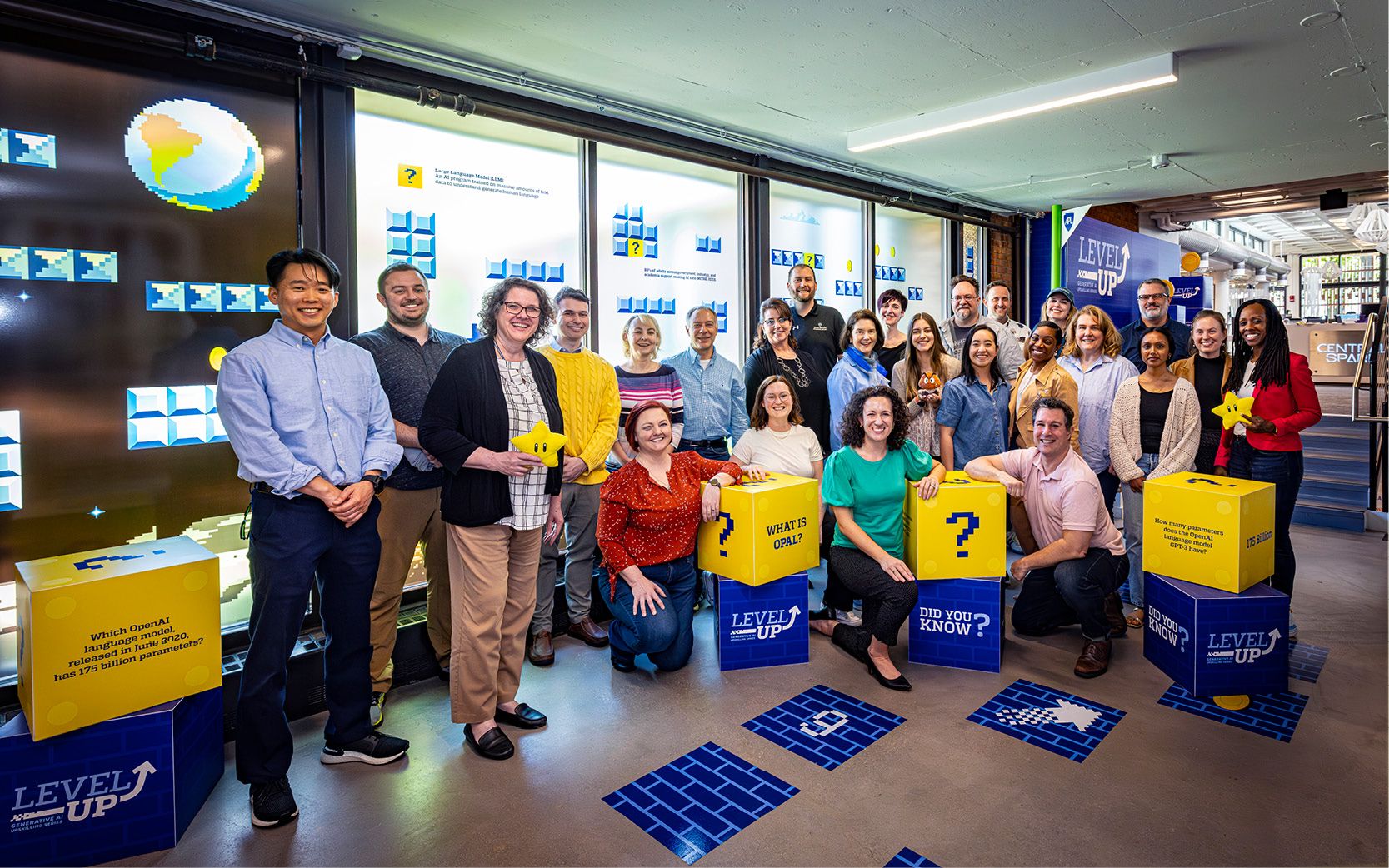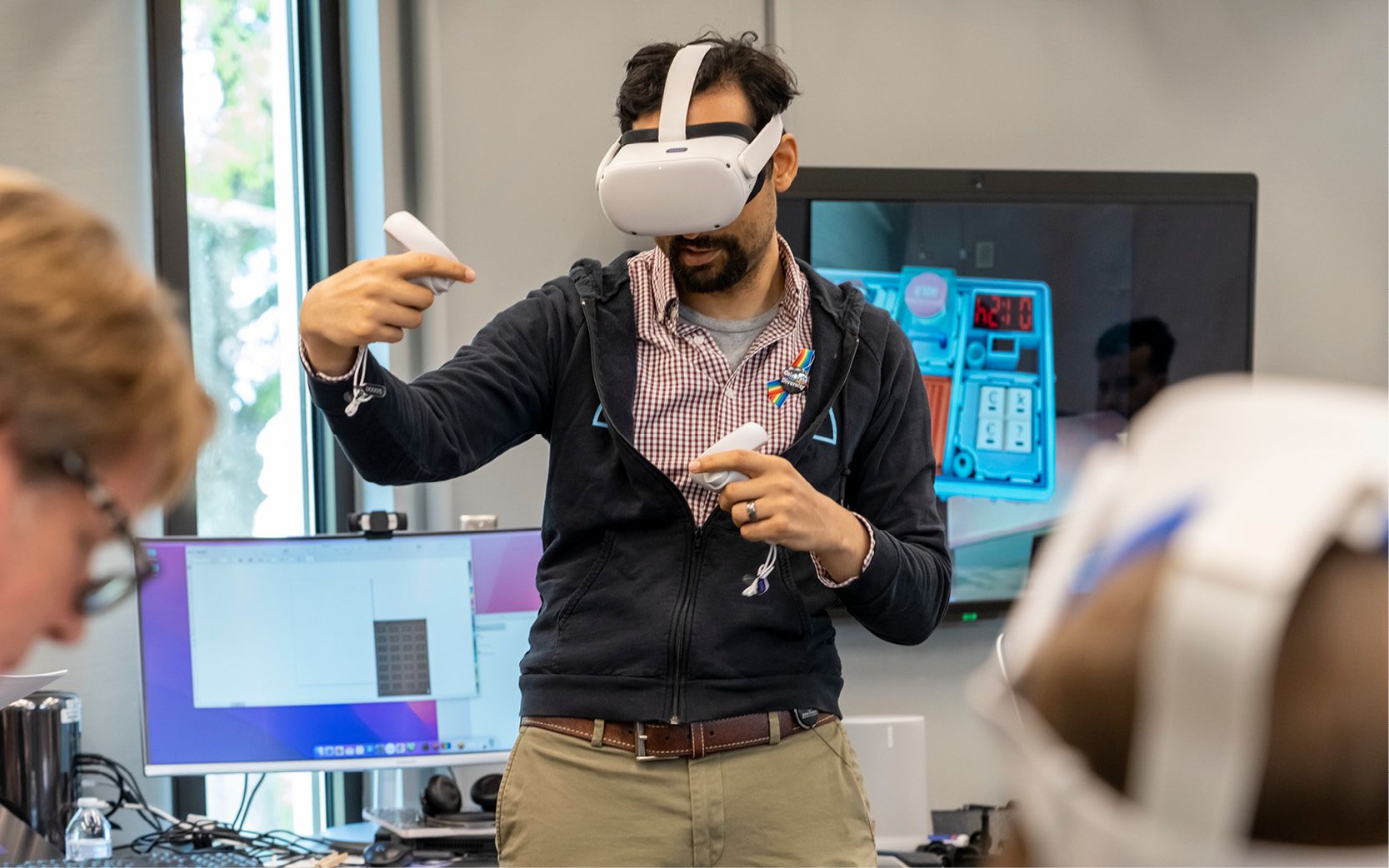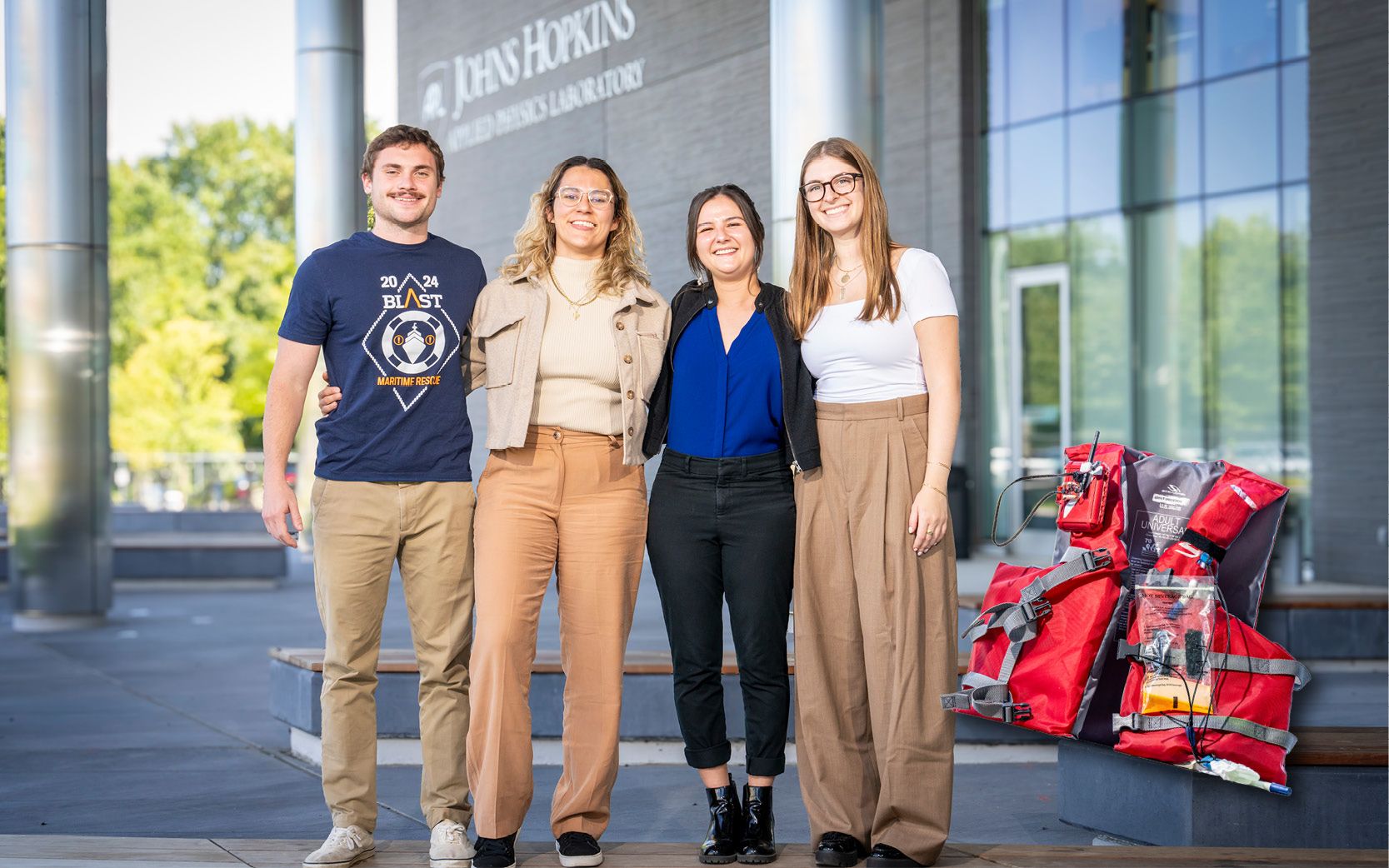From incubating bold research proposals and developing the next generation of leaders to building collaborative workspaces, APL fuels creativity and new ideas at every level.
Groundbreaking ideas can emerge from anyone and any corner of the Laboratory. To foster creativity and collaboration, APL encourages staff to pursue innovative concepts by offering a comprehensive grant system and promoting teamwork through various initiatives.
In 2024, several participation records in these initiatives were broken, celebratory milestones were achieved and countless creative sparks were ignited that will bring forward the next game-changing innovation.
Level Up!
Generative artificial intelligence (AI) is a transformative technology with the potential to enhance productivity and free up creative capacity for APL staff members to tackle the critical challenges facing our sponsors and the nation. To help staff embrace generative AI as a creative collaborator and learn how to use it effectively, APL launched Level Up!, an upskilling series aimed at encouraging adoption and application of these new tools.
The series included a training competition, microtraining sessions, hands-on demonstrations and an engagement campaign featuring fun challenges designed to help staff “level up” their skills in the fast-evolving AI landscape. Foundational training covered large language models, ethics, security, prompt engineering, software development, productivity and using AI to create art and videos. With a broad range of topics and accessible formats, Level Up! was designed to engage all APL staff, not just AI experts.
“We appear to be in a transformational technology shift where the tools and workflows we use may be impacted. This has huge implications across several fields with the potential to raise productivity, speed and scale,” said Patrick Amato, APL’s chief IT strategist for generative AI. “As we move forward, it’s important for staff members to be comfortable with this new technology and to know what it is, but also to know what it isn’t.”

The team behind Level Up!, an upskilling series of educational, informative and interactive experiences to encourage staff members to use generative AI.
Through Level Up!, more than 1,500 APL staff members were trained to effectively use generative AI. Interest continues to grow, with approximately 65% of staff accessing large language models from Laboratory devices in 2024.
“At APL, we foster a culture of innovation, and Level Up! was designed to empower staff to explore the potential of this groundbreaking technology,” said Briana Vecchio-Pagán, program manager for Innovation and Collaboration and Level Up! lead. “Generative AI offers exciting opportunities to enhance divergent thinking, spark creativity and accelerate brainstorming and ideation, benefiting everyone at APL, no matter their role.”
In addition to Level Up!, APL invested in generative AI technologies to give staff members the tools they need to explore and innovate. Among these resources is an on-premise large language model that hosts various open-source versions and includes a secure environment approved for controlled unclassified information. Additionally, the Lab deployed a research computing cluster dedicated to generative AI that supports high-throughput encoding and transfer-learning research.
Central Spark
One of the Laboratory’s premier innovation and collaboration spaces, Central Spark celebrated its 10th anniversary in 2024. The milestone provided an opportunity to reflect on how far APL has come in this arena with the perspective a decade can bring. While APL has always focused on addressing critical challenges, in the early 2010s, the Laboratory sought new ways to elevate innovative capabilities and foster creativity and collaboration. One was the creation of Central Spark — a combined design-thinking and maker space open to the entire Lab, intended to foster collaboration and freethinking with minimal constraints.
At Central Spark, staff members can pursue innovations for projects related to sponsor programs or use their free time for personal endeavors. In 2020, a group of staff members used the space’s 3D printers to produce personal protective equipment for health care workers during the COVID-19 pandemic, addressing a critical shortage.

APL hosts sponsor visits and team-building events at Immersion Central in Central Spark. Central Spark fosters collaboration and creativity, providing a dynamic environment where teams can engage in hands-on, immersive experiences to drive forward innovative solutions.
The space also offers professional development and collaboration opportunities with 30 different classes and trainings. Among the most popular are 3D Printing 101, Vinyl 101 and textile manufacturing classes. During APL’s Innovation Fest — an annual series of events that celebrates and inspires innovation through education, networking and collaboration — Central Spark hosted over 100 classes in just one week. In 2024, the space received more than 200,000 visits.
Central Spark’s success has drawn attention from peer organizations like NASA’s Goddard Space Flight Center and the Los Alamos National Laboratory, whose teams have toured the 9,000-square-foot facility for insights and inspiration in establishing their own innovation and technology hubs.
BLAST
When early-career and new staff members join APL, they have numerous opportunities to collaborate and develop their innovation skillset. One unique initiative is the BLAST program — Building Leaders, Accelerating Science and Technology — an annual innovation challenge designed specifically for early-career staff and those new to APL.
BLAST fosters collaboration and harnesses APL’s innovative culture by bringing together diverse teams from across the Laboratory to solve technical challenges relevant to the Lab and our sponsors.
Participants are grouped in small, cross-disciplinary teams before the annual challenge is announced in order to encourage diverse perspectives and networking opportunities. Once the challenge is announced, these teams then work throughout the summer to respond to the challenge and develop demo-ready prototype solutions. These solutions are presented to a panel of judges.
The program not only helps develop future APL leaders but also promotes the value of multidisciplinary teams and cross-Lab collaboration. It offers early-career staff valuable experience managing projects and budgets, as well as opportunities to expand their networks and build relationships with senior staff, who serve as advisers and as judges.
In 2024, BLAST had record applications, with over 150 staff members applying. Ten teams developed technologies to locate or rescue people under distress in maritime environments. The 2024 winning team developed a wearable prototype to improve large-scale search-and-rescue efforts in low-visibility environments using luminescent visual aids, health-monitoring biosensors and a radio frequency mesh network to connect those in distress with rescuers.

The BLAST Maritime Rescue first place team — (from left) Jack Maher, Maria Castaño, Tina Zudock and Samantha Lomuscio — developed the ALIVENET prototype, an innovative system using luminescent visual aids, biosensors and a radio frequency mesh network to enhance search-and-rescue efforts in low-visibility environments.
BEACON Innovates
Behind APL’s game-changing technical innovations are hundreds of operations, administrative and business staff members who continually enhance the Lab’s processes and workflows to enable critical work in support of our sponsors. In 2024, APL launched BEACON — the Business, Enterprise-service, Administration, Communications and Operations Network — to transform how the Lab’s staff members collaborate and drive operational excellence.
As part of this initiative, the BEACON Innovates challenge accelerates solutions for enterprise operations, business, service, communications and administrative challenges and processes. This year, staff focused on two challenges: optimizing space and technical facility use at the Lab and improving processes within APL’s operations community.
The challenge received over 30 submissions, with three ideas selected for funding and implementation over 10 weeks. Winning teams proposed solutions to develop a wayfinding app for APL staff and visitors, employ advanced sensor technology to optimize office space use and create a standardized, comprehensive training course for administrators across APL.
Project Catalyst
Project Catalyst is a Labwide science and technology grant program that provides staff the opportunity for significant funding, sometimes over multiple years, to test critical assumptions, investigate phenomena and push the boundaries of knowledge and what is possible. Since its launch, the program has awarded over 600 grants ranging from $10,000 to $500,000.
Project Catalyst offers three tiers of internal funding:
IGNITION GRANTS are awarded for solutions to themed challenges. These grants support initial hypothesis testing. Winners are determined through a Labwide voting process and by a panel of challenge representatives.
COMBUSTION GRANTS are somewhat larger and fund visionary ideas that have the potential to advance the state of the art and address sponsor challenges. Proposals are reviewed by APL peers and a panel of technical leaders.
PROPULSION GRANTS support high-risk, high-reward projects. These grants aim to find game-changing solutions to critical challenges that have yet to be solved through conventional methods. The projects can span multiple years, are competitively selected and compete for subsequent-year funding.
Sustained internal support from APL’s Innovation and Collaboration Program can elevate what began as a creative idea into a tangible solution. “We can’t predict the future,” noted Jason Fayer, assistant program manager for the Laboratory’s Innovation and Collaboration Program. “However, Project Catalyst empowers our researchers to conduct extensive experimentation and foster a deeper understanding of what that future will look like.” One project that exemplifies this strategy is APL’s development of the Virtual Intelligent Peer-Reasoning agent known as VIPR.
In 2021, John Winder, a computer scientist, and Tom Urban, then the supervisor of APL’s Intelligent Combat Platforms Group, submitted a proposal to Project Catalyst’s “If Droids Could Think, Then What Would That Mean?” challenge. Their idea centered around pushing the boundaries of what AI can do in air combat.
Rather than seeking to replace pilots, the APL team sought to enhance and complement their abilities, intuition and experience with machine speed and precision. Over the course of three years, they created VIPR, an AI teammate that serves a pilot in three critical capacities: as a situationally aware peer, a performant wingman and a cognitive support assistant.
Winder likens VIPR to R2-D2, the pilot-assisting droid from “Star Wars.”
Developing VIPR has taken a concerted effort on the part of APL scientists and engineers, necessitating multiple major breakthroughs in AI and machine learning techniques. Those advances included the development of machine learning models capable of encoding the (often implicit) observations, beliefs and decisions of a human pilot; applying graph neural networks to the problem of modeling adversary behavior; and the development of a novel, advanced neural network known as a State-Time Attention Network (STAN) for deep multiagent reinforcement learning. STAN enables VIPR to scale its “awareness” to a variable number of entities and to learn a wider variety of multitask behaviors. “Innovative projects such as the VIPR development effort help APL to anticipate future sponsor needs and explore potentially transformative yet risky solutions, enabling us to deliver critical contributions to critical challenges for years to come,” said Erin Conroy, project manager for Project Catalyst.
Now, in its fourth year of Propulsion Grant funding, the APL team is preparing to more formally evaluate its AI prototype with human pilots. But anecdotally, at least, the initial response has been promising.
“We have some former pilots on our team, and they’ve all walked away from engaging in the simulation with smiles on their faces,” Winder said. “And as a non-pilot myself, when I engage in the simulation scenario unassisted, I survive for maybe eight seconds. With VIPR, I’m able to survive and win.
“Obviously, we have much more rigorous testing to do before this can be fielded, but we’re optimistic based on what we’ve seen so far.”
IRAD
The Independent Research and Development (IRAD) program is an innovation cornerstone at APL. Every year, the Lab’s 13 mission areas embark on a search for research and development projects whose solutions have the power to produce breakthroughs on critical national challenges.
IRADs are an important part of APL’s core work and are undertaken in four categories: basic research, applied research, development and systems or other concept formulation studies. IRAD projects solve a problem or discover promising technologies that create novel capabilities and enable new missions for sponsors. Many projects have matured to successfully address ongoing sponsor challenges with real impact on our nation. The process is highly competitive. More than 1,200 IRAD proposals were submitted in 2024, and 340 were funded.
In 2024, some of the most impactful IRADs included projects that are developing novel nonkinetic hypersonic missile defense technologies; software that can identify a drone’s location, speed and direction using audio data; and a virtual reality tool that could help sailors maintain and repair systems on naval vessels.
Janney Grants
APL’s Janney Grants empower staff to engage and collaborate with the broader science and technology ecosystem, both domestically and globally. A key part the Lab’s overall strategy, this collaboration helps APL maintain awareness of emerging technologies and stay on the cutting edge of key competency areas for sponsors.
Janney Grants nurture a culture of discovery, embrace risk and position APL at the center of a vibrant innovation ecosystem. They provide funding for staff to explore new scientific findings and technologies across commercial, public and nonprofit communities, both nationally and internationally.
The grants are most often used to develop publications, present at conferences and help staff advance toward becoming fellows in professional societies.
Named after Stuart Janney Jr., longtime member of the Johns Hopkins University board of trustees and APL board of managers, the program dates back to 1984. Refreshed in 2022, it has grown steadily, with a 45% increase in applications over two years. The revamped program features a simplified application process, tailored mentorships to help staff maximize their awards and expanded collaboration opportunities with JHU and other trusted partners.
Introduced in 2024, the Janney Scholars pilot provides targeted support to high-potential staff seeking elevation to fellow status in one of seven distinguished technical societies. In its inaugural year, the initiative supported 16 participants and resulted in the publication of 12 articles in leading peer-reviewed journals.







